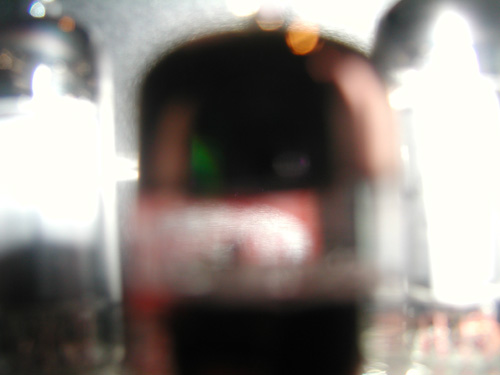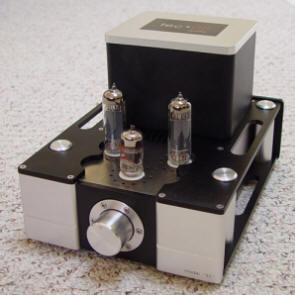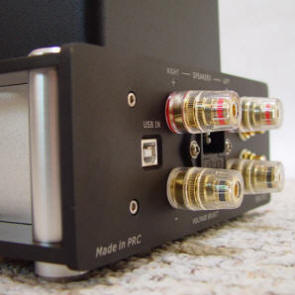|
You are reading the older HTML site Positive Feedback ISSUE january/february 2008
the Cantle of the Cacophonophilist
- the next step: a review of the
Tec-On Model "55"
integrated
Hello everyone, and welcome back to the crazy cacophonist's reviewing game, where tonight I review the Tec-On Model "55" integrated ($749). I am using the same equipment as before, the Zu Druids and Sony CD Player, all with Zu wire. The new item on the list, the Model "55", was a bit strange at first to set up. It took me a while to figure out how to set up the USB cable connection from device (Tec-On) to my computer. The connection part was the easy bit, the setting up on the computer was the difficult part. After that the rest was simple and clean without any hiccups. This device, from what I recall, did not hum at all compared to the last item I reviewed (the Firestone Amplifiers/Preamplifier mix). This device sounded clean without anything being played through it. Putting a CD on made the music come from the speakers, so everything was working correctly. I had no problems with this device on that realm. The CDs sounded crisp, clear, and not held back. The Tec-On seemed to compliment the system nicely. Now where I had the problem with this device was not with its functionality with the CD player, but rather with its interfacing with the computer. I use my computer for most of my music needs. I use iTunes to listen to music over listening to a CD player. And I don't give a $%@! about "lossless" or losing sound quality with MP3 or anything like that. It all sounds EXACTLY THE SAME. If I listen to a CD, and then I listen to the MP3 version, I hear NO DIFFERENCE in sound quality changes. Playing music from my computer gave me the same sound that I heard from my CDs: crisp, clear, and not held back. But, I digress, the problem that I had with this device, was that if I connected it while iTunes was running, it would cause iTunes to freeze. This happened when I also tried to disconnect it with iTunes running (I tried it both with music playing and without music playing, with the same results). Not that one would do either while running iTunes, but that was an issue. I also didn't like how while I was playing a computer game, the Druids would play all that too. If this device came with software to regulate the music from other sounds produced by the computer it would make it 100% more desirable for a college student like myself. This gigantic error on this device's end caused its unfortunate downfall. The Tec-On's main functionality is flawed. Though, it does work (it allows interface from your computer to sound system with no problems) it does not do it as I would wanted it done.
The volume knob was a bit jumpy at times. I am not sure it if was the device (it happened with the radio, computer, and CD player) but it seems that if set at low, it would be low, but if turned up slightly it jumped up in volume (not terribly, but it was not smooth) too quickly. I found this to be an annoyance. The power switch was conveniently located on the side, no gripe there. The tubes were nicely placed, and the artwork (the logo) was nice and put in an appropriate place. This device, although revolutionary to me, does not do what its main feature is supposed to do: easily play music from my computer. It is a device that should be looked at as a learning device for future products using this technology. As done before I like to score the things I review and here is the scoring card:
Dad here, I mean I just got to add my 2 cents worth… so okay what does this all mean? I helped Peter set up the Tec-On Model "55" integrated and did some listening as well, so let me offer some additional comments from the older audio buffoon perspective.
Additionally, while the unit does allow for two inputs—USB and RCA—there is no option to select either than by the unit's default to USB; if two sources are connected simultaneously the RCA source is automatically muted in preference to that of the USB. So I guess you either use it with a computer (via USB) or use with another source (via RCA), but not both at the same time. Peter's frustration was that he wanted to do both—use it with his computer when he wanted to listen to iTunes as well as with the Sony when he wanted to listen to CDs. Going back and forth was an issue as he had to close iTunes every time he wanted to swap the unit (via the inputs) in or out. This is something Peter has not experienced before as he runs his computer via his soundcard (Creative Audigy 2 ZS) into his Altec Lansing gaming speakers. And since that is so...this is not an issue of the "55", just how things work. Plus, in his case at least, placement meant that he needed to run a long USB cable resulting in a degree of hum being audible, though apparently this hum was an issue of the specific USB cable used with the "55" and not the unit by its self. Changing to a different cable resulted in the hum completely disappearing. Obviously, the buyer needs to check the USB cable to make sure it is compliant with the "55". Sound quality was rather robust with somewhat of a "loudness" contour being evident; this was audible in a nice little bass boost that made Peter's system really rock. The unit was, as he said, quite crisp and clear (in audio speak it is nicely transparent) with little if any audible grain and grit. Not bright mind you, just evenly balanced from the mids on up. That is, the "55" is quite smooth and musical, heck, even Peter commented on more than one occasion that he thought the unit sounded richer or fuller than his usual set-up (and that's a lot to have coming from him!). Of course at only 5-watts or so, the "55" was a sonic match made in heaven for the Druids which is why it sounded rather good in his system. But with such efficient speakers combined with the preamp's gain, the volume ramped up a bit too fast for his taste. Of course with such a low-powered amplifier one needs to carefully consider the right speakers. The "55" showed no issues with long term use, in that it never gave any signs of distress or being unhappy. The "55" was also very simple and easy to set-up. It is designed and built to a level that defies its rather affordable price. The "55" is a fun option for those of us who want a nice computer-based system to play our tunes on. Mighty impressive and worth an audition. even Peter misses it! Tec-On Audio http://www.teconaudio.com A Manufacturer's Response to Peter & Dave Clark's review of the model "55". I would like to thank Peter & Dave Clark for their insightful review of the tec•on model "55" and for publishing it in the well-respected Positive Feedback Online. We are of course delighted by the very positive reaction to the style and ease of use of our mini amp, and particularly by the description of its sonic performance: transparency, clarity, musicality are terms that confirm that the "55" is definitely meeting the goals that we had set-up for it. We wanted to offer a unique product, with modern design and quality electronics delivering the solid sound staging that we call our "pristine soundscapes"©, all in a compact package and at a price point that is considered "affordable". The review makes it clear that this has been achieved. Beyond these positive aspects, as Peter notes, the model "55" is quite revolutionary. The unique USB input and on-board DAC makes it possible to link directly to a computer or music server. Here, our original objective was to extend the concept of an existing, conventional mini tube amp with a direct link to a computer for "multimedia". A Burr Brown PCM 2702 chip set, considered one of the standard for 16 bits stereo 44.1kHz DAC by audiophiles, was used to link to the USB port of a computer or server. The implementation of the USB interface appears to fall short of Peter's expectations. However, given the vast range of computers, operating systems, media players and servers, we knew that complexity could sink the execution quickly. We wanted to have an [almost] foolproof solution, at the cost of flexibility or even some functionality. This was a basic decision, made to keep the product easy to use and affordable. For instance, it was decided that USB would have priority, and that the USB cable would have to be disconnected to play through the RCA inputs. This was done, with due respect for audiophiles, to positively avoid "clicks" that may happen when spurious signals come through the USB from poorly controlled programs and to avoid early cut-offs from end-of-tracks fades. Also, the USB Audio Device as implemented is not programmable: it is automatically detected by the computer and, hopefully, will successfully run through a "plug-and-play" routine to make the system as easy and robust as possible. USB devices are supposed to hot-plug without problems. Unfortunately, programs misbehave, and it is not unknown for "freezes" to happen. We have extensive experience with Windows operating systems for which no problems were encountered. On the other hand, misbehaving of OSX and iTunes has been reported by others. Peter's vision is from someone who comes from the computer side and wants to extend functionality of the audio capabilities. Our original vision originated from the audiophile side, with an attempt to extension to digital capabilities. Thus, Peter might find that the "computer-ability" of the model "55" does not go far enough, however for audiophiles or music lovers with more limited PC abilities [myself included!], we hope to have made it easy to run a digital input without sweat! There are of course many opportunities to develop devices that are more directly "software controllable", but surely they will be more complex and more costly. Concluding with PFO Editor's own words describing the "55" as "mighty impressive and worth an audition", I would like to again extend my sincerest thanks to the wonderful father & son reviewers' duo for their informative and very positive review! Pierre Tecon tec•on audio
|




 The Tec-On Model
"55"
preamplifier features 4.5-watts via a single-ended
design based on EL84 tubes. The cool part is that it has
an internal sound card (Brown-Burr delta/sigma 44.1kHz)
which allows for direct USB connection; the computer
sees the Tec-On Model "55" preamplifier as an outboard
sound device. Easy plug and play with Windows (XP here);
no compatibility issues at all as the computer simply
shows an outboard audio device. But, this was not the
device Peter thought it was. He was under the impression
that it would allow him to play music from his computer
while he was actively engaged with his friends in an
on-line game—engaged that is by hearing the sounds and
effects of the game combined with the requisite verbal
interaction with other gamers to make things click. See,
with the "55", while Peter was gaming (plotting the next
move with co-gamers via his headphones and microphone
via a shared "chat" connection), he could not listen to
music from his computer (either MP3 files or whatever)
when connected to the "55". You can do one or the other,
but with the "55" and a computer, not both at the same
time. Not a fault of the "55" (seems that this is really a
computer issue …make that a motherboard issue in how
audio signals are routed), but something that was
important to Peter …being able to do both from his
computer. I guess that that would be nice for a college kid
to be able to do, but for me it is simply music or
nothing when at the computer.
The Tec-On Model
"55"
preamplifier features 4.5-watts via a single-ended
design based on EL84 tubes. The cool part is that it has
an internal sound card (Brown-Burr delta/sigma 44.1kHz)
which allows for direct USB connection; the computer
sees the Tec-On Model "55" preamplifier as an outboard
sound device. Easy plug and play with Windows (XP here);
no compatibility issues at all as the computer simply
shows an outboard audio device. But, this was not the
device Peter thought it was. He was under the impression
that it would allow him to play music from his computer
while he was actively engaged with his friends in an
on-line game—engaged that is by hearing the sounds and
effects of the game combined with the requisite verbal
interaction with other gamers to make things click. See,
with the "55", while Peter was gaming (plotting the next
move with co-gamers via his headphones and microphone
via a shared "chat" connection), he could not listen to
music from his computer (either MP3 files or whatever)
when connected to the "55". You can do one or the other,
but with the "55" and a computer, not both at the same
time. Not a fault of the "55" (seems that this is really a
computer issue …make that a motherboard issue in how
audio signals are routed), but something that was
important to Peter …being able to do both from his
computer. I guess that that would be nice for a college kid
to be able to do, but for me it is simply music or
nothing when at the computer.